Der Modix BIG-120Z V4 ist die neueste Version des extrahohen FDM-3D-Drucker-Kits zur Selbstmontage des Unternehmens. Dieser großformatige modulare 3D-Drucker, der auf den professionellen Markt ausgerichtet ist, zeichnet sich durch seine Fähigkeit aus, superhohe Objekte in einem Stück zu drucken. In der Tat bietet er ein riesiges Druckvolumen in Kombination mit einer hochgradig aufrüstbaren Struktur. Seine Modularität lässt Raum für eine breite Palette von Add-ons, die die Druckmöglichkeiten des Benutzers erweitern.
Als Teil der Generation 4 der beliebten Modix Big Series verfügt das Modell 120Z über einen verbesserten Funktionsumfang, ein überarbeitetes Design und eine fortschrittliche Mechanik. Die Maschine verfügt über eine Reihe neu gestalteter Schlüsselkomponenten und hochwertiger Premium-Teile, nämlich die elektronische Erweiterungsplatine Duex 5, die eine vollständig automatisierte Kalibrierung ermöglicht, stärkere Nema-23-Motoren und CNC-gefräste Halterungen für einen wesentlich schnelleren und stabileren Druck, optische Endschalter für eine höhere Genauigkeit und Wiederholbarkeit, ein verbessertes PTFE-Schlauch- und Kabelmanagement für eine reibungslose und bequeme Wartung, einen integrierten Crash-Detektor für zusätzliche Sicherheit und eine integrierte Not-Aus-Taste, die eine sofortige Reaktion gewährleistet. Darüber hinaus verfügen alle Modelle der Generation 4 über aktualisierte Konstruktionsmerkmale wie einen pneumatischen Deckel, eine Wartungsklappe an der Rückseite, robuste Türscharniere, Tür- und Deckeldichtungsstreifen und eine verbesserte LED-Innenbeleuchtung. Außerdem verfügen sie über einen Glühfadensensor, der eine mögliche Verstopfung erkennt, und eine Wi-Fi-Verbindung für die Fernsteuerung. Darüber hinaus hat das Unternehmen ein brandneues IDEX-Add-on auf den Markt gebracht, das neue Möglichkeiten für den Druck mit unabhängigen Dual-Extrudern und wasserlöslichen Filamenten eröffnet.
Der BIG-120Z V4 kann erfolgreich in einer Reihe von technischen und künstlerischen Branchen eingesetzt werden, z. B. in der Automobilindustrie, im Bauwesen, bei der Herstellung von Konsumgütern, im Bildungswesen usw. Er dient als zuverlässiges Werkzeug für die Herstellung von Kunstmodellen, Funktionsprototypen, Endprodukten, hochwertigen Ersatzteilen, Dekorationsdisplays und vielem mehr. Scrollen Sie nach unten für weitere Informationen.
Wie Sie auf dem Bild unten sehen können, kann der BIG-120Z sogar eine Person in Originalgröße drucken.

Der Modix BIG-120Z ist ein großformatiger professioneller 3D-Drucker, der Teile mit einer Genauigkeit von 40 Mikrometern und glatten Außenflächen drucken kann.

Die Z-Achse des Druckers wurde mit starken Nema-23-Motoren und zuverlässigen CNC-gefrästen Halterungen ausgestattet, die das Bett fest halten und die Druckgenauigkeit insgesamt erhöhen.

Dank der besseren Motoren auf der X-Achse (im Vergleich zu den NEMA-17-Motoren der V3) bietet die BIG-120Z V4 einen viel schnelleren Druck als zuvor. Die Maschine verfügt über eine beschleunigte Verfahrgeschwindigkeit von bis zu 350 mm/s und eine Druckgeschwindigkeit von bis zu 250 mm/s.

Ab der Generation 4 werden die Modix-Geräte mit der elektronischen Erweiterungsplatine Duex 5 ausgeliefert, die für jeden Motor der Z- und X-Achse einen eigenen Schrittmotortreiber bereitstellt. Dank dieser wichtigen Verbesserung bietet der Drucker nun einen vollständigen Satz automatischer Kalibrierungsroutinen, einschließlich automatischer Bettneigung, Bettnivellierung, Gantry-Ausrichtung und Z-Offset-Kalibrierung, die für eine verbesserte Druckpräzision sorgen.

Eine weitere wichtige Verbesserung ist der neue Griffin-Druckkopf. Bisher war er nur ein optionales Upgrade, jetzt wird er standardmäßig in alle V4-Drucker des Unternehmens eingebaut. Er besteht aus einem speziell angefertigten Extruder von Bondtech und einem neuen, von Modix entwickelten Hotend. Das Upgrade bietet ein intelligentes und kompaktes Design, eine hohe Durchflussrate, erhöhte Zuverlässigkeit, einen einfachen Austausch und eine hohe Widerstandsfähigkeit gegenüber hohen Drucktemperaturen, was insgesamt zu einer verbesserten Benutzererfahrung führt.

Die verbesserten optischen Endschalter bieten eine höhere Genauigkeit und Wiederholbarkeit über einen längeren Zeitraum, was besonders wichtig für die Wiederherstellung des Drucks nach Stromausfällen ist.

Dies sind nur einige der bemerkenswerten Verbesserungen, die die neue Version bietet.
Der Modix BIG-120Z wird mit 0,4-, 0,6- und 0,8-mm-Düsen geliefert. Er unterstützt außerdem alle kompatiblen Düsen mit einem Durchmesser von bis zu 1,2 mm. Je nach Ihren Druckanforderungen können Sie die von Ihnen bevorzugte Düsengröße frei wählen. Der Drucker kann auch mit dem IDEX-Add-on für den Multimaterialdruck komplexer Innengeometrien ausgestattet werden.
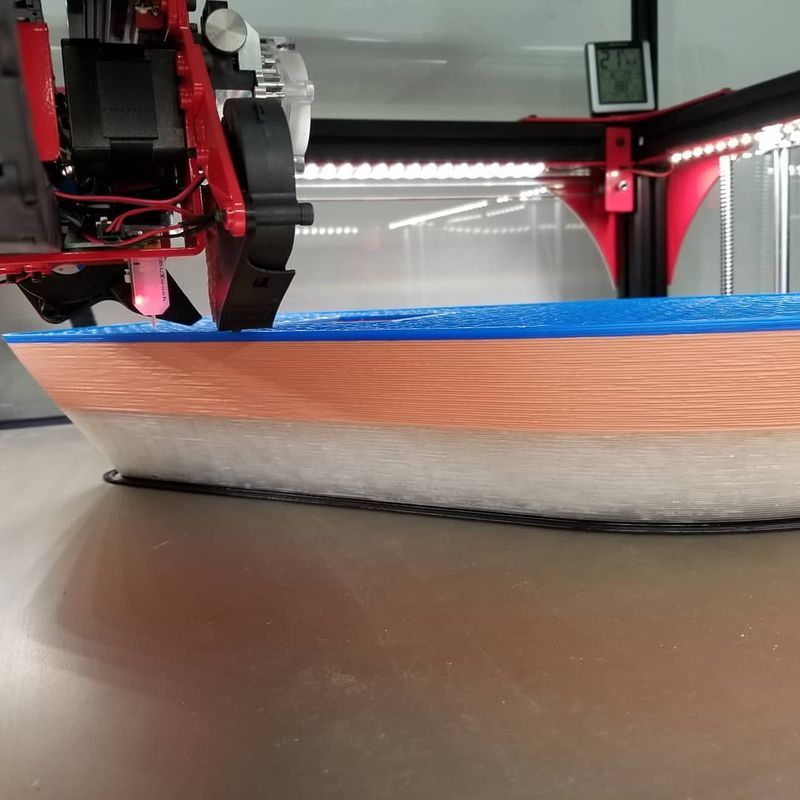
Kredit: @ecostruder / Instagram
Der Druckkopf läuft auf HIWIN-Bewegungsschienen, was den Druck zuverlässig, schnell und präzise macht.
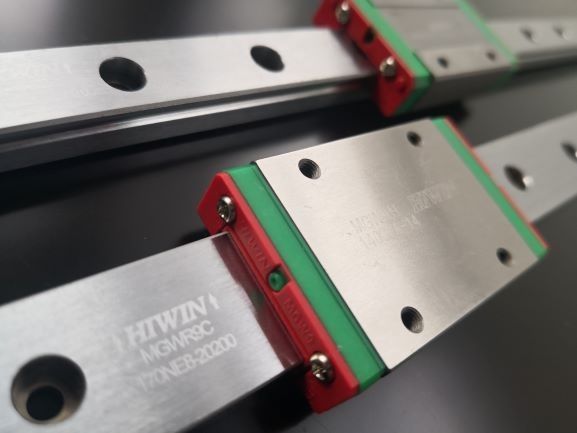
Der technisch ausgereifte Extruder ermöglicht die Verarbeitung einer Vielzahl von Filamenten, darunter PLA, PETG, PVA, ABS, ASA, PC, Nylon, TPU, Woodfill, Carbon Composite und andere exotische Materialien.
Das optionale IDEX-Zusatzmodul umfasst ein sekundäres Drucksubsystem, bestehend aus einem Griffin-Druckkopf, einem Verstopfungsdetektor, PTFE und einer Spulenhalterung. Es ermöglicht den hochwertigen Druck von mehrfarbigen und löslichen Materialien.

Der BIG-120Z V4 unterstützt ein zusätzliches Gehäuse, das aus Aluminiumverbundplatten besteht. Die Installation des Gehäuses führt zu einer besseren Wärme- und Geräuschisolierung.

Der V4 verfügt standardmäßig über einen Verstopfungsdetektor, der Filamentauslauf, Unterextrusion und Verstopfungen im Hotend leicht erkennen kann, so dass der Benutzer das Problem schnell beheben und negative Auswirkungen auf die Qualität der gedruckten Objekte vermeiden kann.

Darüber hinaus kann das (separat erhältliche) 8-kg-Spulenregal mehr Rollen aufnehmen als das Standardregal (bis zu 3 kg). Diese praktische Erweiterung hilft auch den Extrudern, Filament leicht zu ziehen und ist großartig für nahtloses Drucken bei Großprojekten.
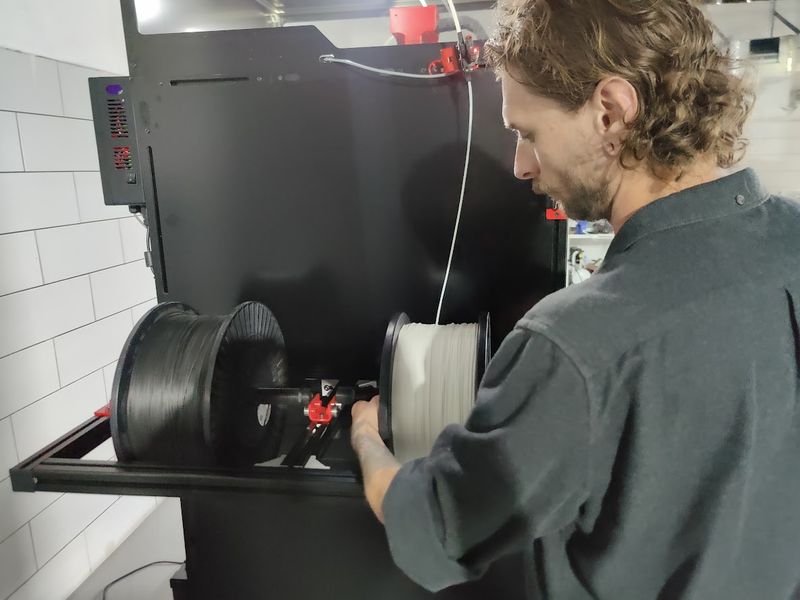
Der Modix BIG-120Z V4 verfügt über ein offenes Materialsystem. Das bedeutet, dass Sie mit jedem 1,75-mm-Filament eines Drittanbieters drucken können. Es scheint auch, dass einige Benutzer das Gerät modifiziert haben, um erfolgreich mit 2,85 mm Materialien zu arbeiten.
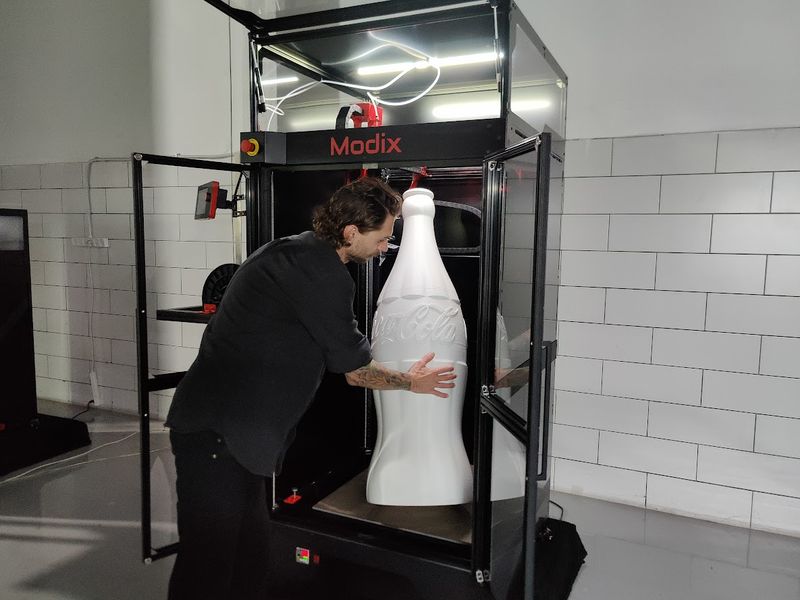
Mit einem Arbeitsbereich von 23,6 x 23,6 x 47,2 Zoll (600 x 600 x 1200 mm) können Sie sehr hohe Modelle in einem Stück drucken, wie diese 1,2 Meter hohe Coca-Cola-Flasche.
Der Modix BIG-120Z V4 verfügt standardmäßig über einen praktischen, geneigten 7-Zoll-Touchscreen, eine große sekundäre Nottaste und einen Netzschalter an der Vorderseite. Sie können den Drucker entweder über einen USB-gebundenen Computer oder direkt über den Touchscreen bedienen.
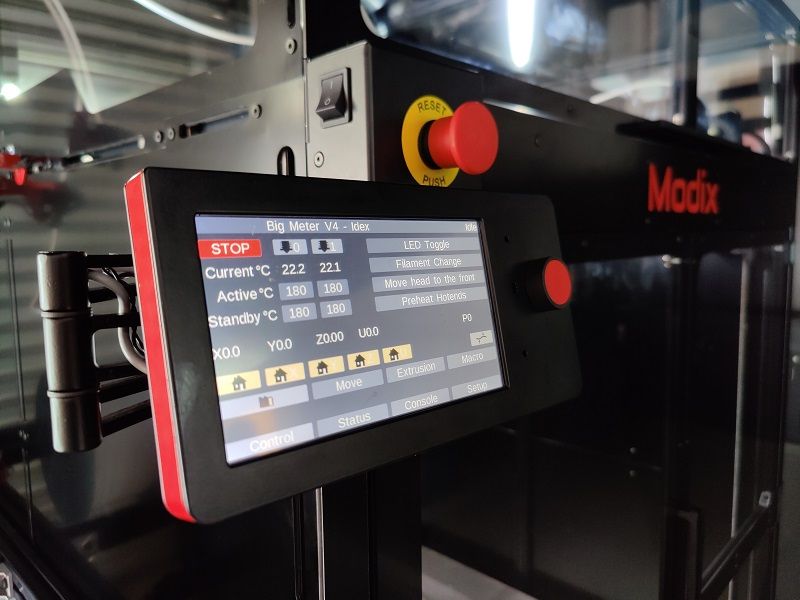
Sie können Ihre 3D-Modelle ganz einfach per USB-Kabel oder über eine externe SD-Karte von einem Computer übertragen. Sie können sie auch über Wi-Fi mit einem PC oder einem Mobiltelefon teilen.

Der Drucker ist mit den wichtigsten 3D-Dateiformaten kompatibel. Daher kann er mit fast jeder 3D-Druck-Slicing-Software arbeiten, einschließlich Cura, Slic3r, Simplify3D, Printerface und vielen anderen.

Der Drucker wird in mehreren Kartons geliefert, die Folgendes enthalten:
Bei einigen Artikeln kann sich der Packungsinhalt ändern. Falls Sie Fragen haben, kontaktieren Sie uns bitte.

Der Modix BIG-120Z V4 wird mit einem schwarzen Metallrahmen und einem optionalen geschlossenen Gehäuse aus Aluminiumverbundplatten geliefert. Sein elegantes Aussehen und sein großes Volumen machen ihn ideal für professionelle Anwendungen in einer Vielzahl von Branchen.
Die Abmessungen des Druckers betragen 35,7 x 41,7 x 78,7 Zoll (906 x 1060 x 2000 mm). Der Spulenhalter ist an der linken Seite des Geräts angebracht.
Der Preis für den Modix BIG-120Z V4 3D-Drucker beträgt 7,500.00€, was in Anbetracht der Funktionalität, der riesigen Baufläche und der hochwertigen Ergebnisse angemessen ist.
Die Modix-Garantierichtlinien finden Sie unter dem unten stehenden Link:
https://www.modix3d.com/modix-general-terms-and-conditions-of-online-sale/
Update your browser to view this website correctly. Update my browser now